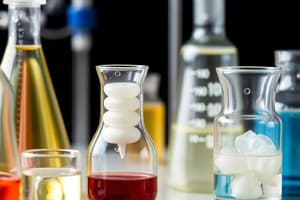Podcast
Questions and Answers
What is the main purpose of filtration?
What is the main purpose of filtration?
- Remove small solid particles from a mixture
- Separate a solid from a liquid (correct)
- Separate mixtures of liquids with different boiling points
- Remove impurities from two solids
Why is vacuum filtration used instead of gravity filtration?
Why is vacuum filtration used instead of gravity filtration?
- Liquid particles are too small and block the filter paper
- Solid particles are too small and block the filter paper (correct)
- Solid particles are too large to pass through the filter paper
- Liquid particles are too large to pass through the filter paper
Distillation is effective because:
Distillation is effective because:
- Components of the mixture are in the same physical state
- Liquids in the mixture have different boiling points (correct)
- Solids in the mixture have different melting points
- Molecules in the mixture have different colors
Recrystallization is primarily used to:
Recrystallization is primarily used to:
Chromatography separates compounds based on differences in their:
Chromatography separates compounds based on differences in their:
Gravity filtration differs from vacuum filtration in that gravity filtration relies on:
Gravity filtration differs from vacuum filtration in that gravity filtration relies on:
What is the primary factor that leads to the separation of compounds in gas chromatography?
What is the primary factor that leads to the separation of compounds in gas chromatography?
Which compound is expected to be retained the longest in gas chromatography?
Which compound is expected to be retained the longest in gas chromatography?
In gas chromatography, which detector burns all organic compounds and detects current?
In gas chromatography, which detector burns all organic compounds and detects current?
What is the purpose of the liquid solvent or mixture of solvents in liquid chromatography?
What is the purpose of the liquid solvent or mixture of solvents in liquid chromatography?
Which component of a chromatograph contains the stationary phase and interacts with sample components?
Which component of a chromatograph contains the stationary phase and interacts with sample components?
What property is used for separation in liquid chromatography?
What property is used for separation in liquid chromatography?
What is the purpose of wetting the filter paper with a small amount of solvent or solution before pouring the liquid mixture into the Büchner funnel?
What is the purpose of wetting the filter paper with a small amount of solvent or solution before pouring the liquid mixture into the Büchner funnel?
What role does turning on the vacuum source play in the filtration process described?
What role does turning on the vacuum source play in the filtration process described?
Why are different boiling points of components important for effective distillation?
Why are different boiling points of components important for effective distillation?
How does ethanol's lower boiling point compared to water relate to its intermolecular forces?
How does ethanol's lower boiling point compared to water relate to its intermolecular forces?
What is the primary function of distillation in separating liquid mixtures?
What is the primary function of distillation in separating liquid mixtures?
How does strong hydrogen bonding contribute to higher boiling points in liquids?
How does strong hydrogen bonding contribute to higher boiling points in liquids?
What is the main purpose of a UV-Visible detector in liquid chromatography?
What is the main purpose of a UV-Visible detector in liquid chromatography?
In Size Exclusion Chromatography, why do smaller molecules take longer paths through the column?
In Size Exclusion Chromatography, why do smaller molecules take longer paths through the column?
What is the role of the mobile phase in liquid chromatography?
What is the role of the mobile phase in liquid chromatography?
Why do larger molecules move more quickly through a Size Exclusion Chromatography column?
Why do larger molecules move more quickly through a Size Exclusion Chromatography column?
How are components separated in liquid chromatography?
How are components separated in liquid chromatography?
Which type of liquid chromatography is specifically used to separate biomolecules based on their size?
Which type of liquid chromatography is specifically used to separate biomolecules based on their size?
Why do larger molecules elute first in chromatography?
Why do larger molecules elute first in chromatography?
What happens when a salt and sand mixture is combined with water?
What happens when a salt and sand mixture is combined with water?
What is the main principle behind the separation of molecules in chromatography?
What is the main principle behind the separation of molecules in chromatography?
Why are smaller molecules retained for a longer time in chromatography?
Why are smaller molecules retained for a longer time in chromatography?
What is the purpose of the detector in chromatography?
What is the purpose of the detector in chromatography?
Flashcards are hidden until you start studying
Study Notes
Filtration and Its Variants
- Main purpose of filtration is to separate solids from liquids.
- Vacuum filtration uses suction to accelerate the filtration process, making it faster than gravity filtration.
- Gravity filtration relies on the force of gravity to pull the liquid through the filter, which can be slower than vacuum filtration.
Distillation
- Distillation is effective because it separates components based on differences in boiling points.
- Different boiling points are crucial to ensure effective separation during distillation.
- Ethanol has a lower boiling point than water due to weaker intermolecular forces, facilitating easier evaporation during distillation.
- The primary function of distillation is to purify liquid mixtures by separating components.
Chromatography Techniques
- Chromatography separates compounds based on differences in their affinities for the stationary and mobile phases.
- In gas chromatography, the separation of compounds is primarily influenced by their vapor pressures.
- Larger hydrocarbons typically have lower vapor pressures and are expected to be retained longer in gas chromatography.
- A flame ionization detector in gas chromatography burns organic compounds to detect electrical current.
Liquid Chromatography
- Purpose of the liquid solvent is to dissolve the sample and carry it through the chromatographic system.
- The stationary phase exists within the chromatograph, interacting with sample components and facilitating separation based on various properties.
- Property used for separation in liquid chromatography can include polarity, size, or charge.
- Wetting the filter paper with solvent minimizes the loss of sample during filtration.
- Turning on the vacuum source enhances filtration speed by creating a pressure differential.
Size Exclusion Chromatography (SEC)
- In Size Exclusion Chromatography, smaller molecules take longer paths due to their ability to enter pores in the stationary phase, thereby increasing their travel time.
- Larger molecules move more quickly through the column because they are excluded from the pores.
- SEC specifically separates biomolecules based on size.
General Chromatography Principles
- In chromatography, components are separated based on their differing interactions with the stationary and mobile phases.
- Larger molecules elute first as they do not interact strongly with the stationary phase and can flow through the columns more freely.
- Smaller molecules are retained longer due to their interactions with the stationary phase or being trapped in small pores.
Additional Details
- When a salt and sand mixture is combined with water, the salt dissolves while the sand remains undissolved, illustrating the principle of solubility in chromatography.
- The purpose of the detector in chromatography is to quantify and identify the separated components as they elute from the column.
Studying That Suits You
Use AI to generate personalized quizzes and flashcards to suit your learning preferences.




